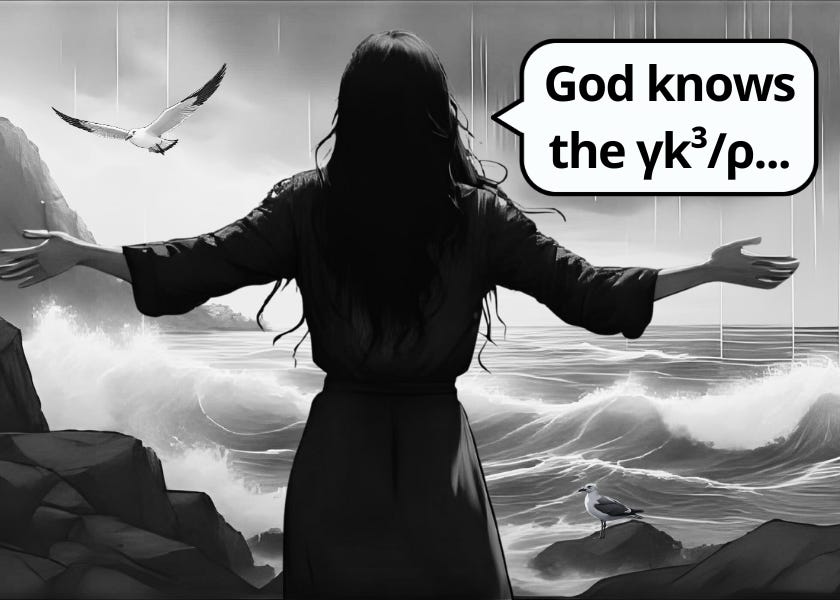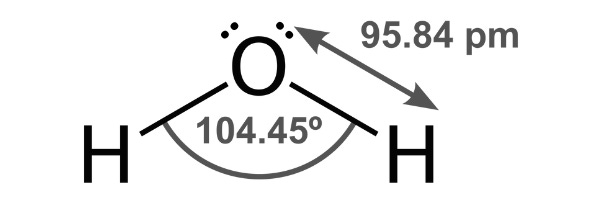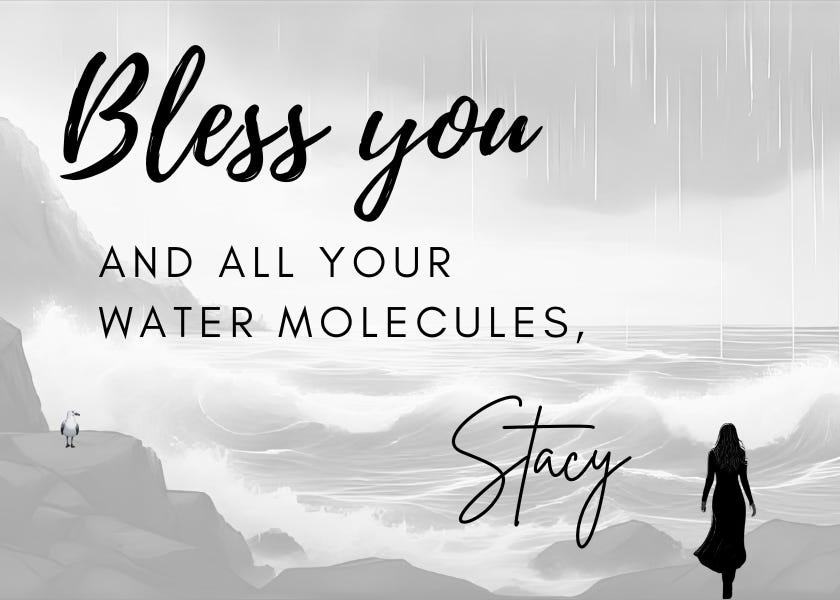An editor once told me that every time a writer uses an equation, she loses 40% of her audience. I have no idea who calculated that, but please don’t click away. This post is lifechanging, and you should not die without reading it.
Chemistry helped me make sense of suffering.
I’m not talking about a bad experience with chemistry in high school in the sense that chemistry itself is a source of great pain. I’m sorry if you feel that way; your teacher failed you. What I mean is that knowing something about the underlying atomic realm can inspire confidence in the faithfulness of God. The ancient biblical cultures observed regularities in nature, such as day and night, seasons, life-death-birth, and attributed these cycles to the constancy and loyalty of God. With modern science, humanity now has access to deeper insights than ever before into the order in nature. Yet the amount of information is so much that we often miss astonishingly beautiful truths right in front of us.
Consider, for example, a rain shower.
I was at the pool last week, and it suddenly started to downpour. I’m in Texas, so this is normal. It was sunny, and then boom, it was raining. We exited the pool and hovered under the patio. I turned and saw that the smooth surface of the pool had transformed into an orchestration of complex surface chemistry governed by the interactions of fluid dynamics. I found myself reflecting on suffering, the Bible, and the age-old question posed by Creedence Clearwater Revival.
'Til forever on it goes
Through the circle, fast and slow
I know, it can't stop, I wonder
I wanna know, have you ever seen the rain?
I wanna know, have you ever seen the rain
Comin' down on a sunny day?
I’ll ask you the same: Have you ever really seen the rain?
Order at the Microscale
Life on Earth is sustained by water. Water is a strange molecule. We’ve all seen the Mickey Mouse shape, one oxygen with two hydrogen atoms. (It’s upside down in the drawing below.) The reason the two hydrogens are like mouse ears instead of human ears 180° apart on each side is due to the fact that oxygen has two other pairs of negatively charged electrons (the dot pairs) repelling the hydrogen bonds away so that the H-O-H bond angle is approximately 104.5°. The bond length of 96 picometers (trillionths of a meter) is due to the electron sharing between hydrogen’s one electron and an unpaired electron on oxygen. Think balance. The water molecule, like any molecule, is a delicate balance of forces.
The H-O-H bond angle is not inconsequential. It means that the water molecule is a dipole. One end (the top in the drawing) is more negative due to the nonbonding electron pairs, and the other end (the bottom) is more positive. The electrons on hydrogen are involved in the bond with oxygen, leaving the positively charged single proton nuclei of the hydrogen atoms exposed.
This dipole nature of the water molecule causes the molecules to be “sticky.” The slightly negative ends stick to the slightly positive ends throughout a bulk amount of water. The dipole is the reason water dissolves so many things and is also the reason water, among other things necessary for life, has surface tension.
Water molecules beneath the surface are completely surrounded by, and can stick to, other water molecules. But water molecules at the surface experience an asymmetric situation. They can only stick to the water molecules beneath or beside them because there are none above them. The surface molecules cluster tightly so as to minimize the surface area because all their stickiness is directed into the bulk of the water, producing a “skin-like” effect on the surface. This net inward force is called cohesion. The surface tension (γ) that results is about 72 mN/m at 25°C. Cohesion and the minimization of surface area is also why water droplets falling from the sky form tiny spheres. This is all high school chemistry, but it’s fascinating to just think about when you see rain falling.
Now imagine what happens when the raindrops hit the surface of a pool.
Th drop and pool surfaces collide. A water drop diameter varies from about 1–5 mm. Each one falls with a kinetic energy proportional to its mass, E = ½mv², where m is mass, v is velocity, ~1–5 m/s for raindrops. When each drop hits the water’s surface, its energy deforms the surface and makes a crater. The impact causes a pressure wave, with initial pressures around P ≈ ρv² (ρ is water density, ~1000 kg/m³). Resisting the crater formation is the surface tension of the water and the water’s resistance to flow, i.e., its viscosity (μ ≈ 0.001 Pa·s).
As the water drop’s momentum (mv) transfers to the pool, it causes the crown-like splash we’ve all seen on high-speed videos.
Some energy makes the crown, which can eject secondary droplets. As the crater collapses, capillary waves are set up by other energy. “Capillary waves” are the ripples that radiate out from the collision. They travel outward with a measurable rate governed by the dispersion relation, ω² = γk³/ρ, where k is the wave number, more on that in a bit. These capillary waves are gone within centimeters and in milliseconds. They are different from ocean waves. Ocean waves are larger, slower, and affected by gravity not capillary action. These little waves are due to the cohesion of water molecules at a surface, that is, to surface tension.
The final surface state is governed by thermodynamic equilibrium as the system minimizes surface energy. But that’s if the only one drop falls. This situation is all ordered on the microscale, but as you might have surmised, there are millions of factors along the trajectory of a falling raindrop in nature that could cause variations, such as wind, pressure differences, temperature variation, collisions during fall, and the presence of dissolved substances.
But Chaos at the Macroscale
Here’s the thing—>When a rain shower sends uncountable numbers of raindrops to fall on a pool, it all looks chaotic yet systematic on the macroscale.
The above video and mathematical descriptions are based on an isolated drop under controlled conditions. In a natural setting, not only is the situation messier, but in addition to all the variations, the capillary waves from each drop are close enough to interfere with each other, so there are even more factors to take into account in the changing shape of the water’s surface.
The dispersion relation from above only applies in the context of a water drop hitting a pool, ω² = γk³/ρ. It is a relation that describes how small capillary waves propagate on water’s surface, dominated by surface tension instead of gravity. The equation says the square of the angular frequency (ω²), which is how fast a wave oscillates at a fixed point, is proportional to the cube of the wave number (k³), which is 2π/λ (λ being the wavelength), scaled by the ratio of surface tension to density of water (γ/ρ). Capillary waves have short wavelengths, and thus larger k values, which means they move fast. As raindrops of various sizes hit the pool, smaller ripples move faster than larger ones, and they run into each other in wildly varying interferences, producing the intricate yet chaotic patterns I saw in the pool that day. It is all a direct consequence of the water seeking to restore itself to equilibrium after each drop makes its collision. I took this video.
When I watched the water, I had the same feeling I have at an orchestra concert. The music happens so fast, beat by beat, that a listener in the audience has no prayer of discerning individual players or individual notes. It almost sounds chaotic in the sense that so much is happening faster than you can keep up with, but it also is not chaotic in the sense that the music is an orchestration.
This (don’t laugh) honestly causes me pain. I suffer when I hear orchestra music, especially when I am at a live concert. I am racked with the guilt of ingratitude because I know that I am failing to fully appreciate all the details that cause the beauty in front of me. Then I am pained because those thoughts keep me from appreciating the actual music, so I try to shut down my thoughts and just appreciate the music in the moment. It hurts! Sure, someone could slow the music down and ask each player to take turns playing his or her note for each beat, but to do that would be to destroy the music and turn it from music into individual sounds. I had the same mental conflict watching the rain on the pool. So many complex interactions, gone before I could appreciate them.
And…Suffering?
The Book of Job in the Bible is a story of a man who lost everything, family, wealth, health, only to argue with God and submit in humility to the divine order before having his wealth restored. According to the New American Bible, the book is “an exquisite dramatic treatment of the problem of the suffering of the innocent.” (It is a “literary composition,” and not a “transcript of historical events and conversations.”) Job demands to see God so he can ask God directly why he is suffering so undeservedly. Instead of answering with an explanation of divine justice, God reminds Job of the wonders of creation. Ouch!
Where were you when I founded the earth?
Tell me, if you have understanding.
Who determined its size? Surely you know?
Who stretched out the measuring line for it?Into what were its pedestals sunk,
and who laid its cornerstone,
While the morning stars sang together
and all the sons of God shouted for joy?Who shut within doors the sea,
when it burst forth from the womb,
When I made the clouds its garment
and thick darkness its swaddling bands?When I set limits for it
and fastened the bar of its door,
And said: Thus far shall you come but no farther,
and here shall your proud waves stop?"
Have you ever in your lifetime commanded the morning
and shown the dawn its place
For taking hold of the ends of the earth,
till the wicked are shaken from it?
To be honest, God’s admonishment in this story always makes me mad. If I were Job, I would say, “Thanks God! But can you please give me a straight answer?” Many times, I have said that to God while shaking my fists. God never calls me up to a mountain and writes my instructions and explanations down the way I want Him to, though. Just as He reminds Job that humans do not command the waves, dictate night and day, or produce the stars or clouds, He reminds us too.
Regarding rainfall, we can’t predict where the very next raindrop will land on Earth. Think about it. Not just on Earth, but we cannot predict even where rain will fall in a small space. If you drew a square meter of land and tried to predict within that space when and where the next raindrop would exactly fall, you never could. There are too many factors in the rest of the universe you cannot account for. You can observe, theorize, and try to discover the relations between physical laws by isolating events to the point you can measure them, but all the isolated efforts are but single notes in an orchestra beyond human comprehension.
Incidentally, the Book of Job was composed between the seventh and fifth centuries B.C., but later in 55–57 A.D., St. Paul wrote a letter to the Christians at Rome with the same encouragement, echoing Job (11:35): “Or who has given him [God] anything that he may be repaid?” And ends with: “For from him and through him and for him are all things. To him be glory forever. Amen.”
In the seventh to fifth centuries B.C. as well as in the first century A.D., no one knew about fluid dynamics, dispersion equations, or the bond angles in the water molecule. But these laws were still true, still there, nonetheless. We discovered them because we, human persons, came to trust there is order in nature, “…from him and through him and for him are all things.” Our answers to suffering may vary, but they can be found in this doxology. While a rain shower plays out, God knows all the ω² = γk³/ρ dispersion relations in every collision. To him be glory forever. Amen.
The cognitive dissonance I described about nature, chemistry, and orchestra concerts was something I first encountered in graduate school. I played the violin in my undergraduate university’s orchestra and had played with the big kids since the age of twelve. When I studied science, I was already in tune to the interplay of isolated individuals in united systems. As a girl, I practiced my individual part, but as member of the orchestra, I was part of something bigger. The orchestra director led us to play in the concerts, but we played music from a mind we had never met, and often from a composer who lived long before any of us.
I came to realize that an atheistic view of nature doesn’t offer any cause for all these causes I studied in science. Eventually when facing up to suffering, I could not maintain that view. The atheistic or strictly naturalistic view of the world required me to put blinders on, to keep turning away from looking beyond science—and nothing frustrates a scientist more than being unable or, worse, unwilling to ask why. Why is there order? Why does it seem chaotic yet systematic? Why do I care? And Who is this composer, creator, order-er? Does this entity speak to us? If so, maybe there are answers to more pressing questions beyond science.
That was part of my journey to faith. I now understand why Job and the first Christians inquired into nature to understand suffering and why God said to find our own answers in the order and chaos. My answer, my way of expressing it, is that I am the single raindrop sending out tiny waves in the systematic chaos of the shower, still like that girl practicing the violin for the university orchestra performance. Mostly, I do my part, but it’s not my stage. I am a part of everyone else’s stage. Many times, I operate in isolation, trying like crazy to make the right choices, but I am not in control of how it will all come together in the end.
As I’ve matured, I have gained the gift of hindsight. I can look back and see how beauty emerged from seeming chaos because there was, indeed, an underlying order governing the outcome all along. Yes, I have seen rain come on a sunny day, and more so, yes, I’ve lived to see beauty that comes on the next day. I could tell so many stories, but that will have to wait. You read this far, and I should wrap up.
It’s not that we can avoid suffering in life. We can’t. But good can come from suffering because God is faithful. His faithfulness is on display in any rain shower. God is there, eternally present, there in the storm, there in our suffering, there in the tiniest relations playing out between every electron in every atom in every water molecule all around you right now and throughout the universe for all time. Keep going. Understanding will come.
So, go see the rain and be at peace. Aren’t you happy you didn’t click away?






Great post, Stacy. Just shows that not all beauty is capturable by a picture or a recording. Some is intrinsic to the very structure of things.
The science lesson (from someone who never had to take it) almost hurt my brain.
In return, I offer you a three minute orchestral work by Benjamin Britten: Variations
and fugue on a theme by Purcell. Try to get a Bernstein rendition and play it while
watching the video of the raindrop dance. Be careful, you might swoon.